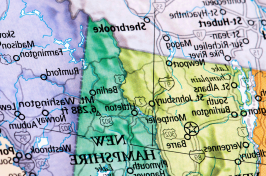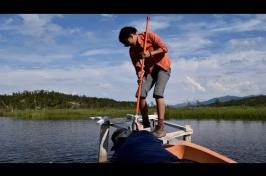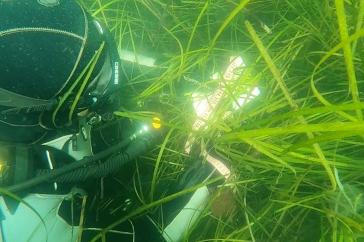Key Research Finding
An effective lion conservation plan requires identifying and addressing the specific ecological and sociopolitical factors that threaten an individual lion population.
The iconic lion (Panthera leo) has been listed as a vulnerable species on the International Union for Conservation of Nature’s Red List of Threatened Species since 1996, due largely to a roughly 43 percent decline in African lion populations since the early 1990s. To combat this decline, lion conservationists and researchers are now developing plans that consider how the ecological and sociopolitical threats to lion populations vary by country. Fikirte Erda, an assistant professor of natural resources and the environment with the UNH College of Life Sciences and Agriculture (COLSA), conducted research to pinpoint the specific stressors that weaken different lion populations in Africa—research that can be used to create more nuanced and targeted lion conservation plans in consideration of these identified stressors. Erda recently joined an international team in publishing her findings in the journal Communications Earth & Environment.
Populations are colour-coded according to whether they scored high (above-mean) or low (below-mean) on both the ecological and socio-political fragility scale. A The fragility status of 84 national lion populations. B The fragility status of 62 geographic lion populations. Source: journal article
Advancing Conservation with Targeted Research and Strategies
“Escalating anthropogenic pressures on resources paint a challenging future for wildlife in general. The situation is particularly dire for lions, given that nearly all of their habitat falls within the bottom 25 percent of the world’s poorest countries,” said Erda, who has studied conservation planning in east Africa since the late 2000s and conservation for megacarnivores like the lion since 2014. “It is unsustainable for the global community to expect some of the world’s poorest communities to shoulder the responsibility of sustaining viable populations of endangered species. This study highlights the ethical and moral obligation of wealthier nations to significantly contribute to the conservation of freely ranging wild lions.”
The dramatic drop in lion populations over just a few decades stems from several ecological factors, such as shrinking habitats and decreased prey populations. Additionally, the strength of governmental conservation plans and general government stability in countries with lion populations are major determinants of lion vulnerability. Lion populations are jeopardized by different ecological and sociopolitical issues depending on the region they inhabit — for example, high human population density affects lions in Tanzania, but is much less pressing in Botswana—which is why broader, nonspecific conservation plans can be ineffective.
“While there has historically been well-researched data tracking lion population size, little research has been done considering the specific threats a lion population faces, and even less that takes socio-political threats into account,” stated Erda. “The strategy of considering population fragility and considering both ecological and sociopolitical variables can and should be applied to other endangered species as well to create more exacting and effective conservation plans.”
A Comprehensive Model for Lion Conservation Success
For this recent study, Erda worked with an international team of research scientists to develop a model for analyzing threats to conservation and to apply this model to lion populations in Africa. They studied 62 free-range lion populations in 25 countries, identifying the extent of ecological and sociopolitical risk for each of these populations.
They evaluated ecological fragility by considering factors such as cattle density, which increases likelihood of lion-human conflict; nearby human population density; isolation of a lion population, which limits genetic variation; population size; and how much lion habitat was in a protected area. Sociopolitical fragility was calculated by examining a country’s existing environmental and conservation policies, the strength and stability of the government, the human growth rate (which increases the strain on health and natural resources), and economic health, since governments may prioritize a struggling economy over conservation efforts.
Using this approach, researchers were able to identify the lion populations facing the highest ecological risks, such as the population in Maze National Park in Ethiopia, where the threat to lions is caused by high density of cattle and human populations surrounding lion territory. They were also able to identify lion populations facing the highest sociopolitical risk. For example, lion populations in Somalia were found to be the most fragile mainly due to lack of governance and conservation policy.
Erda added, “This pioneering research establishes a precedent for a methodological approach to evaluate conservation investments for other wildlife facing ecological and sociopolitical issues."
With a better understanding of the specific threats facing African lion populations, conservation groups can better target their approaches, and governments can work on shaping policy that prioritizes addressing the most pressing dangers to the lions in their individual countries. Additionally, this model can be modified and applied to other endangered species with complex and varied threats to their survival.
This work is co-authored by S. K. Nicholson, A. Dickman, A. Hinks, J. Riggio, H. Bauer, A. Loveridge, M. Becker, C. Begg, S. Bhalla, D. Burnham, A. Cotterill, S. Dolrenry, E. Dröge, P. Funston, L. Hazzah, D. Ikanda, F. Gebresenbet, P. Henschel, R. L. Mandisodza-Chikerema, M. Mbizah, L. Hunter, K. Jacobsen, P. Lindsey, N. Maputla, E. Macdonald, D. W. Macdonald, R. Kantai Duff, C. Packer, C. Sillero-Zubiri, T. Mudumba, P. Strampelli, E. A. Sogbohossou, P. Tyrrell and A. P. Jacobson .
You can read the published article, Socio-political and ecological fragility of threatened, free-ranging African lion populations, in Communications Earth & Environment.
-
Written By:
Maeve Gifford | UNH College of Life Sciences and Agriculture | Maeve.Gifford@volamdolong.com




















































